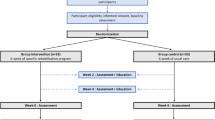Abstract
The objective of this study was to assess the correlation between neurogenic intermittent claudication (NIC) in LSS and different positions as well as loading status, using the treadmill device. The study was a prospective clinical trial on lumbar spinal stenosis (LSS) using a treadmill equipment. The study population comprised of 80 LSS patients with a mean age of 61. The equipment included a treadmill, unloading station and loading vests. The patients were instructed to walk in five different positions. The initiation time of symptoms and total walking time were recorded. The examination was stopped after 20 min or at the onset of severe symptoms. In order to obtain pretest demographic data on subjects, visual analog scale, Roland–Morris questionnaire, pain disability index, and Beck depression index were used. The initiation time of symptoms (ITS) and total walking time (TWT) were measured during the test. Unloading provided a longer and loading a shorter ITS and TWT. Decline or incline positions did not affect ITS or TWT. The changes in posture had no correlation with the appearance of symptoms in LSS patients with NIC on a treadmill in this study, rather ITS and TWT were determined by axial loading and unloading.



Similar content being viewed by others
References
Amundsen T, Weber H, Lilleas F, Nordal HJ, Abdelnoor M, Magnaes B (1995) Lumbar spinal stenosis: clinical and radiologic features. Spine 20(10):1178–1186
Deen HG Jr, Zimmerman RS, Lyons MK, McPhee MC, Verheijde JL, Lemens SM (2000) Test–retest reproducibility of the exercise treadmill examination in lumbar spinal stenosis. Mayo Clin Proc 75:1002–1007
Deen HG, Zimmerman RS, Lyons MK, McPhee MC, Verheijde JL, Lemens SM (1998) Use of the exercise treadmill to measure baseline functional status and surgical outcome in patients with severe lumbar spinal stenosis. Spine 23:244–248
Dong GX, Porter RW (1989) Walking and cycling tests in neurogenic and intermittent claudication. Spine 14(9):965–969
Fritz JM, Erhard RE, Delitto A, Welch WC, Nowakowski PE, Nowakowski PE (1997) Preliminary results of the use of a two-stage treadmill test as a clinical diagnostic tool in the differential diagnosis of lumbar spinal stenosis. J Spinal Disord 10(5):410–416
Fritz JM, Erhard RE, Vignovic M (1997) A nonsurgical treatment approach for patients with lumbar spinal stenosis. Phys Ther 77(9):962–973
Gronblad M, Hupli M, Wennerstrand P, Jarvinen E, Lukinmaa A, Kouri JP, Karaharju EO (1993) Intercorelation and test–retest reability of the pain disability index (PDI) and the Oswestry disability questionnaire (ODQ) and their correlation with pain intensity in low back pain patients. Clin J Pain 9:189–195
Hasegawa T, An HS, Haughton VM, Nowicki BH (1995) Lumbar foraminal stenosis, critical heights of the intervertebral discs and foramina. A cryomicrotome study in cadavera. J Bone Joint Surg Am 77-A:32–38
Herzog RJ, Kaiser JA, Saal JA, Saal JS (1991) The importance of posterior epidural fat pad in lumbar central canal stenosis. Spine 16(Suppl):227S–233S
Inufusa A, An HS, Lim TH, Hasegawa T, Haughton VM, Nowicki BH (1996) Anatomic changes of the spinal canal and intervertebral foramen associated with flexion–extension movement. Spine 21:2412–2420
Iversen MD, Katz JN (2001) Examination findings and self-reported walking capacity in patients with lumbar spinal stenosis. Phys Ther 81:1296–1306
Jensen OH, Schmidt-Olsen S (1989) a new functional test in the diagnostic evaluation of neurogenic intermittent claudication. Clin Rheumatol 8:363–367
Joffe D, Watkins M, Steiner L, Pfeifer BA (2002) Treadmill ambulation with partial body weight support for the treatment of low back and leg pain. J Orthop Sports Phys Ther 32(5):202–215
Johnsson KE, Willner S, Pettersson H (1981) Analysis of operated cases with lumbar spinal stenosis. Acta Orthop Scand 52:427–433
Jonsson B, Annertz M, Sjoberg C, Stromqvist B (1997) A prospective and consecutive study of surgically treated lumbar spinal stenosis. Part 1: clinical features related to radiographic findings. Spine 22: 2932–2937
Kucukdeveci AA, Tennant A, Elhan AH, Niyazoglu H (2001) Validation of the Turkish version of the Roland–Morris disability questionnaire for use in low back pain. Spine 26(24):2738–2743
Onel D, Sari H, Dönmez C (1993) Lumbar spinal stenosis: clinical/radiologic therapeutic evaluation in 145 patients. Spine 18:291–298
Penning L (1992) Functional pathology of lumbar spinal stenosis. Clin Biomech 7:3–17
Penning L, Wilmink JT (1987) Posture-dependent bilateral compression of L4–L5 nerve roots in facet hypertrophy. Spine 2(5):491
Schonstrom N, Lindahl S, Willen J, Hansson T (1989) Dynamic changes in the dimensions of the lumbar spinal canal: an experimental study in vitro. J Orthop Res 7:115–121
Takahashi K, Miyazaki T, Takino T, Matsui T, Tomita K (1995) Epidural pressure measurements: relationship between epidural pressure and posture in patients with lumbar spinal stenosis. Spine 20:650–653
Turner JA, Ersek M, Herron L, Deyo R (1992) Surgery for lumbar spinal stenosis: an attempted meta-analysis of the literature. Spine 17:1–8
Wade DT (1990) Measures of emotion and social interaction. In: Measurement neurological rehabilitation. Oxford University Press, Oxford, pp 259–284
Willen J, Danielson B, Gaulitz A, Niklason T, Schonstrom N, Hansson T (1997) Dynamic effects on the lumbar spinal canal. Spine 24:2968–2976
Author information
Authors and Affiliations
Corresponding author
Rights and permissions
About this article
Cite this article
Oğuz, H., Levendoğlu, F., Öğün, T.C. et al. Loading is more effective than posture in lumbar spinal stenosis: a study with a treadmill equipment. Eur Spine J 16, 913–918 (2007). https://doi.org/10.1007/s00586-007-0317-y
Received:
Revised:
Accepted:
Published:
Issue Date:
DOI: https://doi.org/10.1007/s00586-007-0317-y




